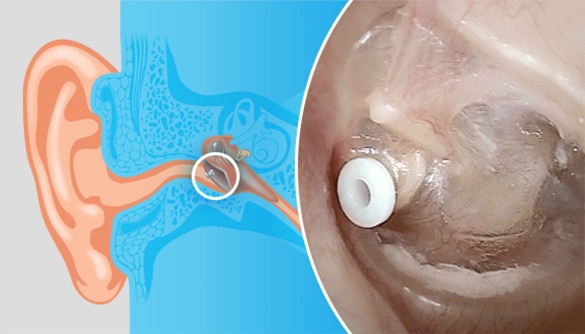Ear Tubes in Children: A Parent’s Complete Guide to Tympanostomy Tubes 2025

If your child has experienced recurring ear infections or persistent fluid in their ears, your pediatrician may have mentioned ear tubes as a potential treatment option. This comprehensive guide will help you understand what ear tubes are, their benefits, and what to expect if your child needs them
Ear infections are painful, and infants between 6-18 months are at highest risk due to the small size of their eustachian tubes which can retain fluid and congestion during colds. If your little one has been congested for about a week and has started waking at night (usually crying until held), it’s time to get their ears looked at by the pediatric office.
My general rule is by the 3rd ear infection of the season they are referred to the nearest ENT office for evaluation for PE tubes. Tubes are helpful to avoid overusing oral antibiotics with every infection. With tubes, ear drops can be used to treat the area of infection without meds entering the gut.
If you aren’t ready for PE tubes, but need help to relieve the pain associated with ear infections, check out this link for the best symptom relief. https://justaskjennp.com/ear-infection-relief/
What Are Ear Tubes?
Ear tubes, also known as tympanostomy tubes or ventilation tubes, are tiny cylindrical devices inserted into the eardrum. These small but mighty tubes:
- Create a pathway for air to enter the middle ear
- Allow fluid to drain from the ear
- Help prevent the buildup of pressure behind the eardrum
- Typically measure about 1.5-3mm in size
- Usually stay in place for 6-18 months before falling out naturally

Who Needs Ear Tubes?
Your child might be a candidate for ear tubes if they experience:
Frequent Ear Infections
- 3 or more infections within 6 months
- 4 or more infections in one year
- Infections that don’t clear with antibiotics
- Recurring infections that affect hearing or speech development
Chronic Fluid Build-up
- Fluid in the middle ear lasting more than 3 months
- Persistent hearing difficulties
- Speech or language delays
- Balance problems due to ear fluid
Other Risk Factors
- Down syndrome
- Cleft palate
- Other conditions affecting ear drainage
- Weakened immune system
The Procedure: What to Expect
Before Surgery
- Pre-operative physical examination done at your pediatric office
- Discussion of medical history
- Hearing test
- Fasting instructions for surgery day
- Instructions about medications
During Surgery
- Takes approximately 15 minutes
- Performed under general anesthesia
- Small incision made in eardrum
- Fluid removed from middle ear
- Tube inserted into eardrum
After Surgery
- Usually outpatient procedure
- Child typically recovers within hours
- May return to normal activities next day
- Follow-up appointment scheduled within few weeks
For more information on the process check out this link https://www.cincinnatichildrens.org/health/p/pe-tube
Care and Maintenance
Daily Care
- Keep ears dry during baths
- Use earplugs when swimming if recommended
- Regular check-ups with ENT doctor
- Monitor for drainage or discomfort
Warning Signs to Watch For
- Yellow, brown, or bloody drainage
- Persistent ear pain
- Fever
- Changes in hearing
- Tubes falling out earlier than expected
Water Precautions
- Discuss swimming restrictions with doctor
- Use ear plugs or swim caps if advised
- Avoid underwater swimming without protection
- Keep soapy water out during baths
Potential Complications
Common Issues
- Drainage from ears
- Tubes falling out too early
- Tubes not falling out on their own
- Small hole in eardrum after tube falls out
When to Call the Doctor
- Severe pain
- Persistent drainage beyond 7 days
- Fever over 102°F
- Changes in hearing or balance
- Tube visible in ear canal
Long-term Outcomes
Expected Benefits
- Fewer ear infections
- Improved hearing
- Better speech development
- Reduced need for antibiotics
- Better sleep and behavior
Success Rates
- 80-90% reduction in ear infections
- Improved quality of life
- Better school performance
- Reduced healthcare visits
- Enhanced speech development
Prevention of Future Problems
Lifestyle Modifications
- Avoid secondhand smoke exposure
- Proper bottle-feeding position
- Regular hand washing
- Up-to-date vaccinations
- Breastfeeding when possible
Conclusion
Ear tubes can be a life-changing solution for children suffering from chronic ear infections or persistent fluid. While the decision to proceed with ear tube surgery should be made carefully in consultation with your healthcare providers, the procedure is generally safe and effective. Most children experience significant improvement in their symptoms, leading to better hearing, fewer infections, and improved quality of life.
Remember that every child’s situation is unique, and what works for one may not work for another. Always maintain regular follow-up appointments with your child’s doctor and stay alert to any changes or concerns that may arise after the procedure.
Disclaimer: This article is for informational purposes only and should not replace professional medical advice. Always consult with your healthcare provider for diagnosis and treatment decisions regarding your child’s specific situation
